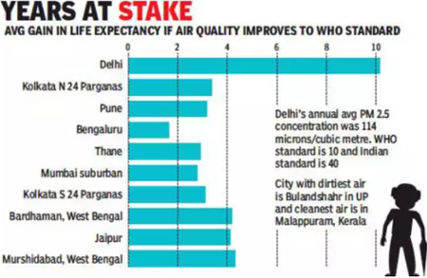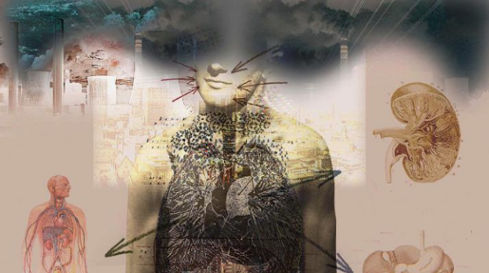INTRODUCTION
Delhi, India’s bustling capital, is facing a grave health crisis. A stark warning from a recent report reveals that if current pollution levels persist, the city’s residents are poised to lose a staggering 11.9 years of their life expectancy, compared to World Health Organization (WHO) guidelines.
This alarming projection is further underscored by a loss of 8.5 years relative to national guidelines. The report’s findings paint a dire picture of the long-term consequences of living in one of the world’s most polluted cities, where toxic air and water are devastatingly affecting human health.
In this article, we’ll examine the report’s key findings, explore the factors driving this health crisis, and discuss the urgent need for action to mitigate the effects of Delhi’s pollution on its residents.
A TOXIC LEGACY: DELHI’S POLLUTION
Delhi’s pollution crisis is a result of unchecked industrialization, rapid urbanization, and a lack of effective environmental regulations. The city’s toxic air, contaminated water, and hazardous waste pose serious health risks.
Air Pollution: Delhi’s air quality is among the worst in the world, with particulate matter (PM) levels exceeding WHO guidelines by 10-15 times.
- The city’s air is laden with toxic pollutants like nitrogen dioxide, sulfur dioxide, and volatile organic compounds, which can cause respiratory problems, cardiovascular diseases, and cancer.
- According to a study, Delhi’s pollution causes over 10,000 premature deaths annually.
Water Contamination: Delhi’s water supply is contaminated with pollutants like lead, mercury, and arsenic, which can cause neurological disorders, kidney damage, and cancer.
- Over 40% of Delhi’s population relies on groundwater, which is often untreated and contaminated.
- A study found that 70% of Delhi’s water samples exceeded WHO guidelines for bacterial contamination.
Hazardous Waste: Delhi generates over 10,000 tons of dangerous waste daily.
- Improper disposal contaminates soil, water, and air, posing serious health risks

WHO GUIDELINES
The World Health Organization (WHO) guidelines for air quality are designed to protect human health from the adverse effects of air pollution. In the context of Delhi’s pollution crisis, these guidelines are particularly relevant.
The guidelines specify that Particulate Matter (PM2.5) levels should not exceed 10 μg/m³ (annual average), PM10 levels should not exceed 20 μg/m³ (annual average), Nitrogen Dioxide (NO2) levels should not exceed 40 μg/m³ (annual average), and Ozone (O3) levels should not exceed 100 μg/m³ (8-hour average).
However, Delhi’s air quality far exceeds these guidelines, leading to severe health implications for its residents. PM2.5 levels exceeded the guideline by 10-15 times, leading to a loss of 11.9 years of life expectancy.
PM10 levels were 5-6 times higher, and NO2 and O3 levels also exceeded guidelines by 2-3 times and 1.5-2 times, respectively. This has resulted in increased cases of respiratory problems, cardiovascular diseases, cancer, neurological problems, and birth defects.
The WHO guidelines serve as a benchmark for Delhi to measure its air quality and take necessary actions to reduce pollution levels and protect public health.
ECONOMIC CONSEQUENCES
A study estimated that the economic burden of air pollution in Delhi is around ₹10,000 crores (approximately USD 1.4 billion) annually. Additionally, pollution-related illnesses lead to absenteeism, reduced productivity, and lost working hours, resulting in economic losses of around ₹15,000 crores (approximately $2.1 billion) annually.
Delhi’s pollution crisis also affects the city’s tourism industry, with air pollution costing around ₹1,200 crores (approximately USD 170 million) annually. Furthermore, pollution affects crop yields, leading to agricultural losses of around ₹2,000 crores (approximately USD 280 million) annually. Infrastructure degradation due to pollution also results in significant economic costs, estimated to be around ₹5,000 crores (approximately $700 million) annually.
The cumulative effect of these economic consequences is a significant loss in GDP. A study estimated that Delhi’s pollution crisis reduces the city’s GDP by around 1-2% annually. Moreover, pollution affects property values, leading to reduced investments in real estate. A report found that air pollution reduces property values by around 10-20%, resulting in economic losses of around ₹10,000 crores (approximately $1.4 billion) annually.
GOVERNMENT RESPONSE
The government response to Delhi’s pollution crisis has been multifaceted, involving various policies and acts aimed at reducing pollution levels. Some key initiatives include
- Comprehensive Plans to Reduce Pollution: Delhi Air Action Plan, Graded Response Action Plan (GRAP) for Delhi-NCR.
- Vehicular Emission Control Measures: Delhi Electric Vehicle Policy 2020, Odd-Even Scheme, Delhi Pollution Control Committee (DPCC), National Capital Territory of Delhi (NCTD) Air Quality Index (AQI) Monitoring.
- Sustainability Initiatives: Delhi Green Cover Enhancement Scheme, Delhi Traffic Management Plan, National Green Tribunal (NGT) Orders, Delhi’s Electric Bus Program, Delhi Smart City Plan, Delhi Waste Management Plan.
A CALL TO ACTION
Delhi’s pollution crisis demands immediate attention, with residents projected to lose 11.9 years of life expectancy if 2021 pollution levels persist, and the city incurs annual economic costs of ₹26,200 crores.
To mitigate this, a collective effort is crucial, involving government policies like enforcing emission standards, promoting clean energy, and enhancing public transportation, as well as private sector initiatives adopting sustainable practices, investing in clean technologies, and supporting green initiatives.
Individuals can also contribute by reducing energy consumption, using public transportation, and participating in local environmental initiatives. With vehicles causing 40% of pollution, industrial activities 20%, and construction 10%, targeted actions can significantly reduce pollution levels, ensuring a healthier, more sustainable future for Delhi’s residents.
CONCLUSION
In conclusion, the report’s findings on Delhi’s pollution crisis are a stark reminder of the urgent need for action. The projected loss of 11.9 years of life expectancy relative to WHO guidelines and 8.5 years relative to national guidelines is a devastating consequence of inaction.
The economic toll of pollution, totaling ₹26,200 crores (USD 3.7 billion) annually, further emphasizes the need for collective effort and policy change. The impact on human health and the economy cannot be ignored, and immediate action is necessary to mitigate these effects.
As we move forward, policymakers, stakeholders, and individuals must come together to address this crisis. By implementing effective solutions to reduce pollution levels and promote sustainable practices, we can ensure a healthier, more sustainable future for the people of Delhi. The time to act is now, to prevent further loss of life and livelihood.
– SHEELU KUMARI
MUST READ: ALARMING RISE STUDENT SUICIDES OUTPACE INDIA’S POPULATION GROWTH


